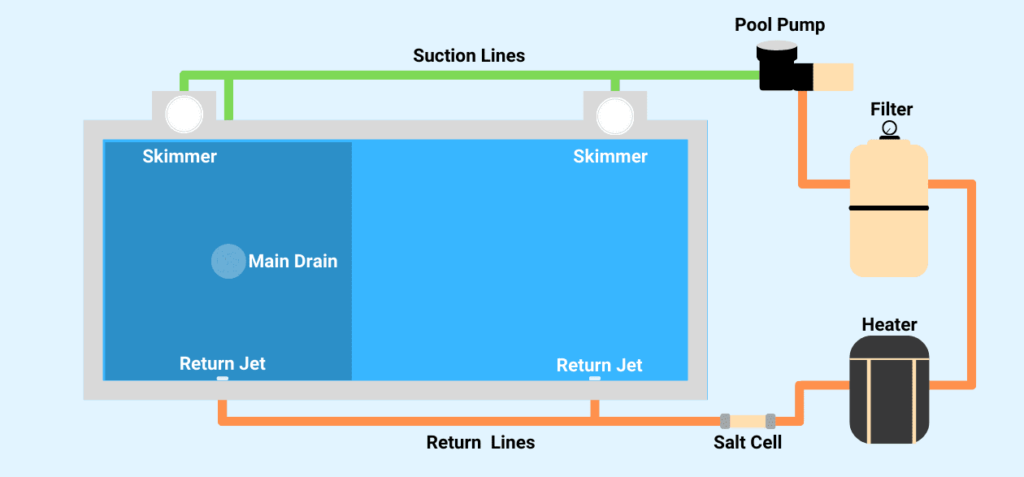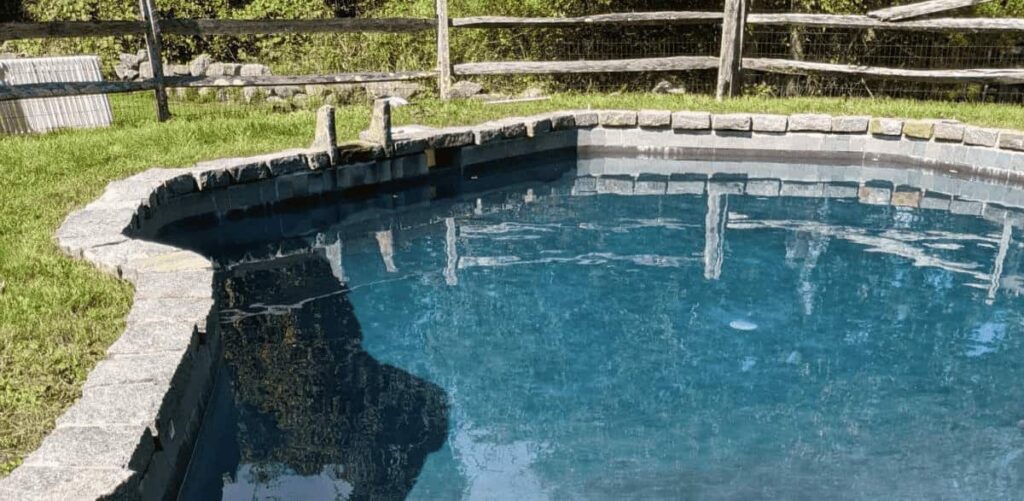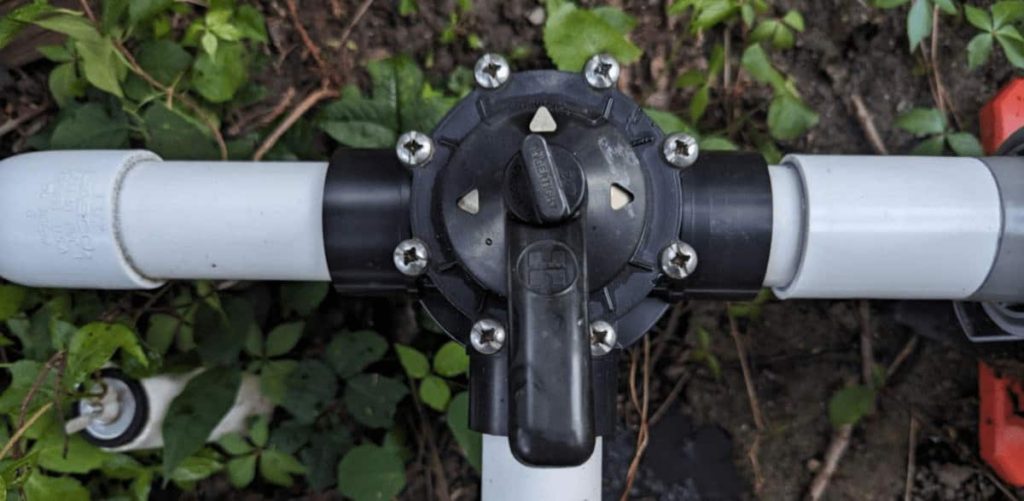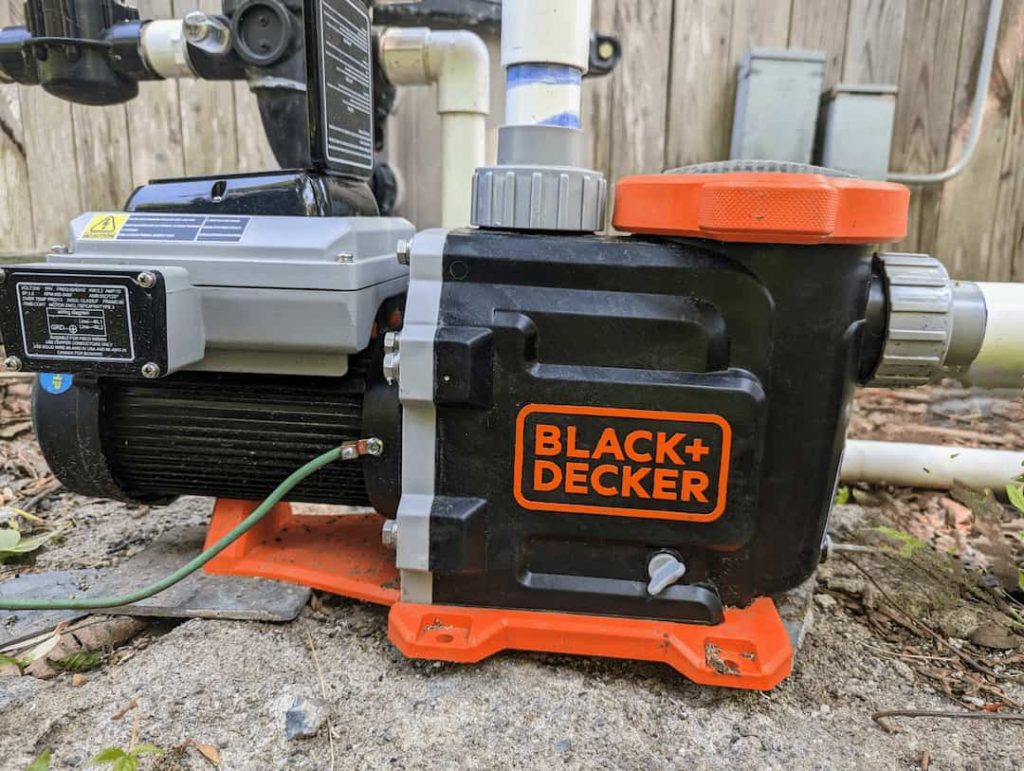Owning a pool can be an overwhelming thought. There are many moving parts of a swimming pool that can break down or stop working at any point in time.
Understanding your pool anatomy and how it works is an important part of being a pool owner. There aren’t that many parts that make up a pool, so having some knowledge will only make maintenance that much easier.
The Importance of Knowing Your Pool
The first step in self-maintenance of an item is understanding how it works and functions. Diagnosing filtration issues and even cleaning the pool requires some basic knowledge of your pool’s anatomy.
Familiarizing yourself with the ins and outs of your pool can help you identify potential issues early on, make informed decisions about pool upgrades, and communicate more effectively with pool service professionals if there is something you cannot fix on your own.
As mentioned above, there aren’t too many parts of a pool to know and it isn’t too complicated to understand, but having basic knowledge will go a long way towards maintaining your pool.
Knowing Your Pool’s Structure
Pools come in multiple shapes, sizes, and colors and can be as customizable or ready-made as you choose.
They are either inground or above-ground.
- Inground pools are built into the ground, with the top typically sitting flush with the lawn or decking. Depending on the type of material used, they can be very customizable and are pretty much a permanent structure in the yard.
- Above-ground pools are semi-permanent structures set on the lawn or a structure. While they can be installed and permanently placed with added decking around them, most above-ground pools can be disassembled or moved around your property at any time.
While there are many different types of material a pool can be made out of, the three most common types are concrete, fiberglass, and vinyl.
No matter what type of pool you have, their parts and functionalities will mostly be the same.
The Parts of a Pool That Make it Run
The pool’s main goal is to keep the water clean and healthy so its owners (you!) can enjoy and swim in it.
Of course, you help by testing and adding the right chemicals, but generally speaking, a pool works by sucking water in, filtering it, and pushing it back into the pool. Simple enough!
Let’s break that down. The pool circulates water through the suction side, the filter system, and the pressure side.
- The suction side of the pool draws or pools water from the pool into the filter system. It consists of skimmers, a main drain, and PVC lines.
- The filter system is the heart of the pool. It pumps the water out of the pool, cleans it, then pushes it back in. The filter system is made up of the pool pump and filter.
- The pressure side, or return side, sends the water from the filter system back into the pool. It primarily consists of the return jets and PVC lines.
Counting them up, we can summarize the important parts of a pool into the main pieces:
- Skimmers
- Main drain
- Suction PVC lines
- Pool pump
- Pool filter
- Return PVC lines
- Return Jets
- Heater (optional)
- Chlorinator / salt cell (optional)
- Water features (optional)

The Suction Side of a Pool
The suction side is the start of the water circulatory system. It begins by bringing water into the pool’s pump and filter where it awaits to be cleaned of any dirt and debris. The first stop is into the skimmers.
Pool Skimmers
Typically built into the walls, pool skimmers have wide openings allowing pool water to enter. They tend to clean the surface of the water. Skimmers themselves have a few different parts.
They typically come equipped with a basket that helps initially catch any larger pieces of debris like leaves and sticks that might have fallen into the pool. These items can be too large for the pump and may even damage the filter so catching them beforehand is very important.
Skimmers can also come equipped with a flapping door in the front of the mouth called a weir door. These help trap items into the skimmer and don’t allow them to escape back into the pool.
At the bottom of the skimmer are openings for water to enter. These are your suction lines.
Main Drain
A main drain’s function is almost identical to a skimmer. The only exception is that it’s primarily found in the deep end.

The main drain pulls in debris below the surface, adding another entry point for suction. Not all pools have a main drain, and they are not necessary, but they can also be used if you need to partially drain the pool.
There are some safety issues with main drains, and newer pools typically have two to reduce the suction force if one drain gets clogged or blocked. You should always make sure the main drains are clear of debris.
Like skimmers, beneath the main drain are suction lines that send water out of the pool.
Suction PVC Lines
Suction lines are typically made of PVC pipe and extend from the skimmers and main drain in the pool pump. These lines typically will have pool valves that can restrict or completely block water flow.

They have one job, and that is to be the vehicle that sends the water into the filter system.
The Filter System
The filtration system is the backbone of the entire pool. In the simplest terms, its job is to make the water as clean, clear, and healthy as possible. The pool pump starts this process.
Pool Pump
The most important part of any pool is your pool pump. It is the epicenter of how your pool will function. We can’t talk about water balance without proper circulation.
Pumps create a continuous flow of water that allows the water to “turn over” or completely pass through the suction, filter, and pressure system.
They also include a strainer basket similar to the baskets in a skimmer, which helps catch any debris the skimmer might have missed before it reaches the filter.

Pumps come in many different types, sizes, and speeds, usually ranging from 0.75 to 3 horsepower (HP). The three most common types of pumps are:
- Single-speed pumps: Operates at one speed
- Dual-speed pumps: Operates in two speeds, a low and high
- Variable speed pumps: Let’s you control your speed to as high or low as you want!
Variable-speed pumps have become popular over the last decade due to their energy efficiency and long-term cost savings. Many energy companies offer rebates and credits for switching to variable-speed pumps.
You should choose the right pump for your pool based on your pool’s size and flow rates.
Pool Filter
Chlorine does a lot to keep the pool’s water clean and healthy, but it can’t get everything. The pool filter’s job is to clean up what chlorine killed and to catch any smaller debris and particles that the skimmer and pump baskets couldn’t catch.
The level of precision by which a filter can catch items is determined by your filter type, which are
- Cartridge filter
- Diatomaceous earth (D.E.) filter
- Sand filter
As the filter fills with organics and other debris, it needs to be cleaned and washed periodically.
Once the water passes through the filter, it continues its journey to return to the pool.
The Pressure Side
The pressure, or return side, is the last step of the journey and ensures clean and healthy water returns to the pool. We start at the return lines.
Return PVC Lines
Like suction lines, these return lines are responsible for sending water back into the pool.
They extend from the pool’s filter, or other optional accessories, to the return jets.
Return Jets
Return jets are the last stop before the water enters back into the pool. They look like little eyeballs and are sometimes referred to as such.
Most return jets have moveable sockets that you can point up, down, or to the sides to better control water circulation.
Play around with the direction that best suits your pool’s water flow.
Optional Equipment to Add to Your Pool
Many pool owners have additional features and equipment to heighten their pool’s appearance and prolong the swimming season.
While these items are not necessary for a pool to work, they can certainly enhance any pool.
Pool Heater
Can you guess what a pool heater does? That’s right, it heats the water so owners can set the water temperature just right and even make their swim season last just a little bit longer.
Heaters can come in a variety of types including, gas, solar, and electric.
If you are using a heater, it should be installed after the filter. Unless you use a chlorinator or saltwater generator, it’ll be the last step in the filter system.
Chlorinator
Chlorinators work by automatically feeding chlorine directly into the pool’s plumbing. This eliminates the need for floating dispensers or manually adding chlorine on a daily basis.
There are various chlorinators depending on the different types of chlorine that you use.
If you are using a chlorinator, it should be the last step of the filter system process after the heater.
Water Features
Waterfalls, fountains, sprays, and bubblers can turn any pool into a backyard oasis! There is something very relaxing about water features and the sound they make when they hit the pool.
Any water feature is pretty much a substitute for return jets as it will be the last step before the water goes back into the pool.
Keep in mind, any water feature above the water level that splashes into the pool will raise pH must faster over time. Aeration causes pH to increase over time, so make sure you are doing regular pool testing to ensure your levels are balanced.
Saltwater Generator
Saltwater generators are a different way to chlorinate the pool. It converts salt that is added to the pool into chlorine so the pool can stay sanitized all the time without the need to manually add chlorine.
The only difference between a salt pool and a “traditional” pool is the saltwater generator itself. They are both considered chlorine pools!
Since these are chlorinators, they should be the last part of the filter system.
Diagnosing Pool Problems and Leaks
Knowing the different parts of a pool can make it much easier to identify problems that may arise. Even if you can’t fix it yourself, being able to pinpoint an area to a pool professional can save a lot of time.
For example, if you suspect you have a leak in the pool, knowing whether it is coming from the suction side, pressure side, or filter system will determine the best way to fix it.
Study Time is Over, Time to Swim!
No matter what accessories or additions you have in your pool, the main parts of a pool will be the same. Understanding how it all comes together will not only help you understand your pool better, it can help you diagnose any problems that may arise faster.
However, now that you do know all of this, school is now out of session so jump in and enjoy!
